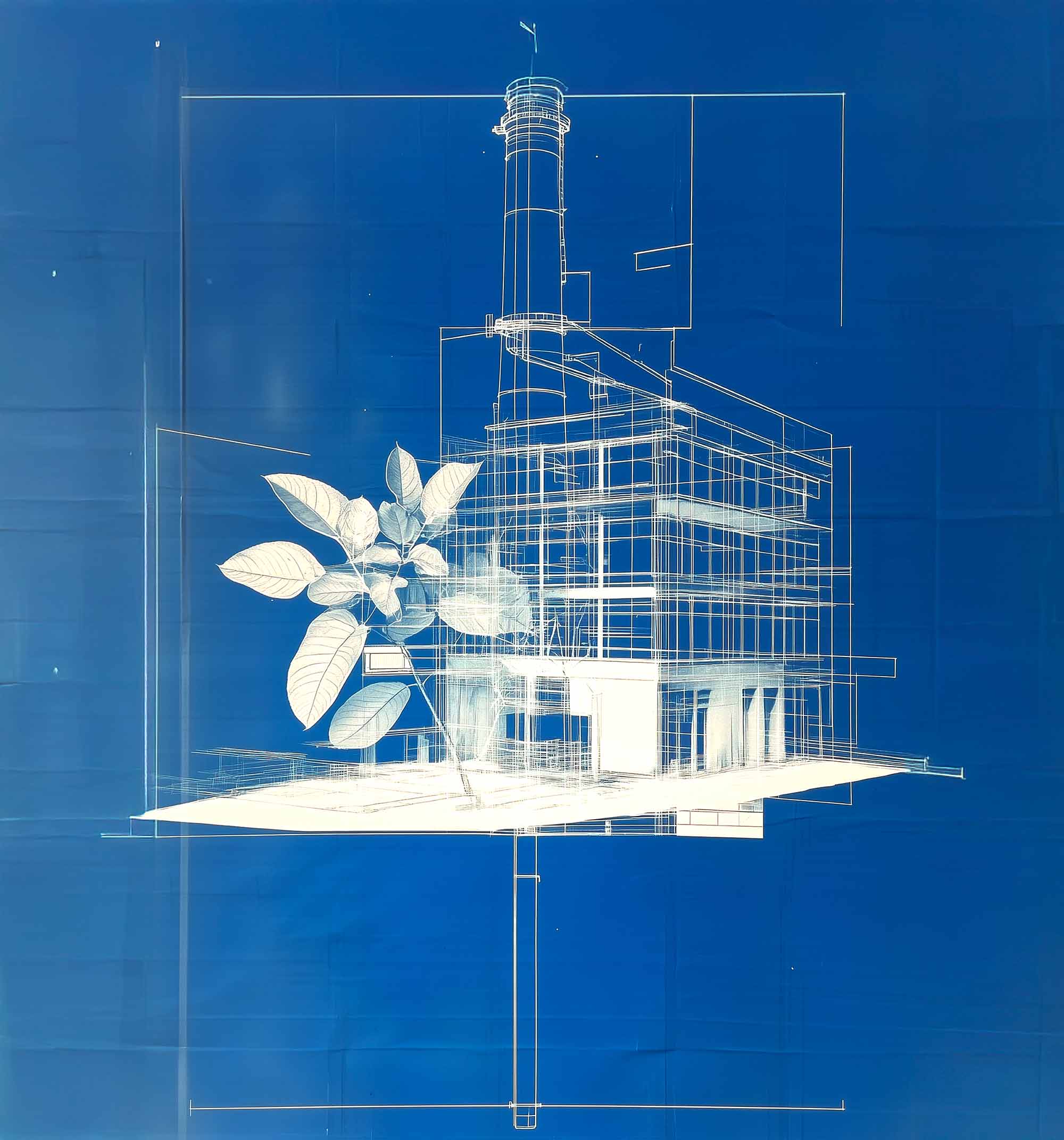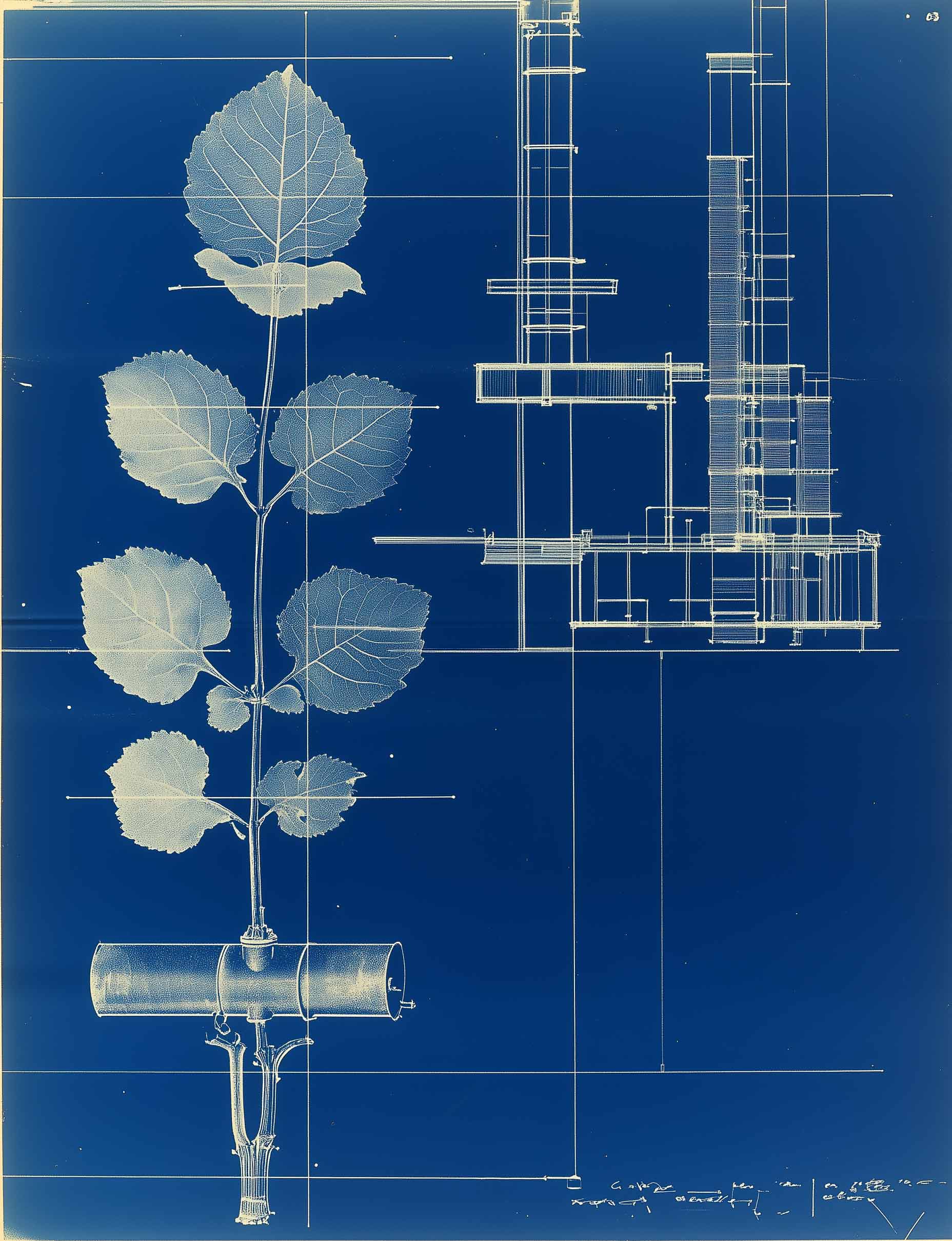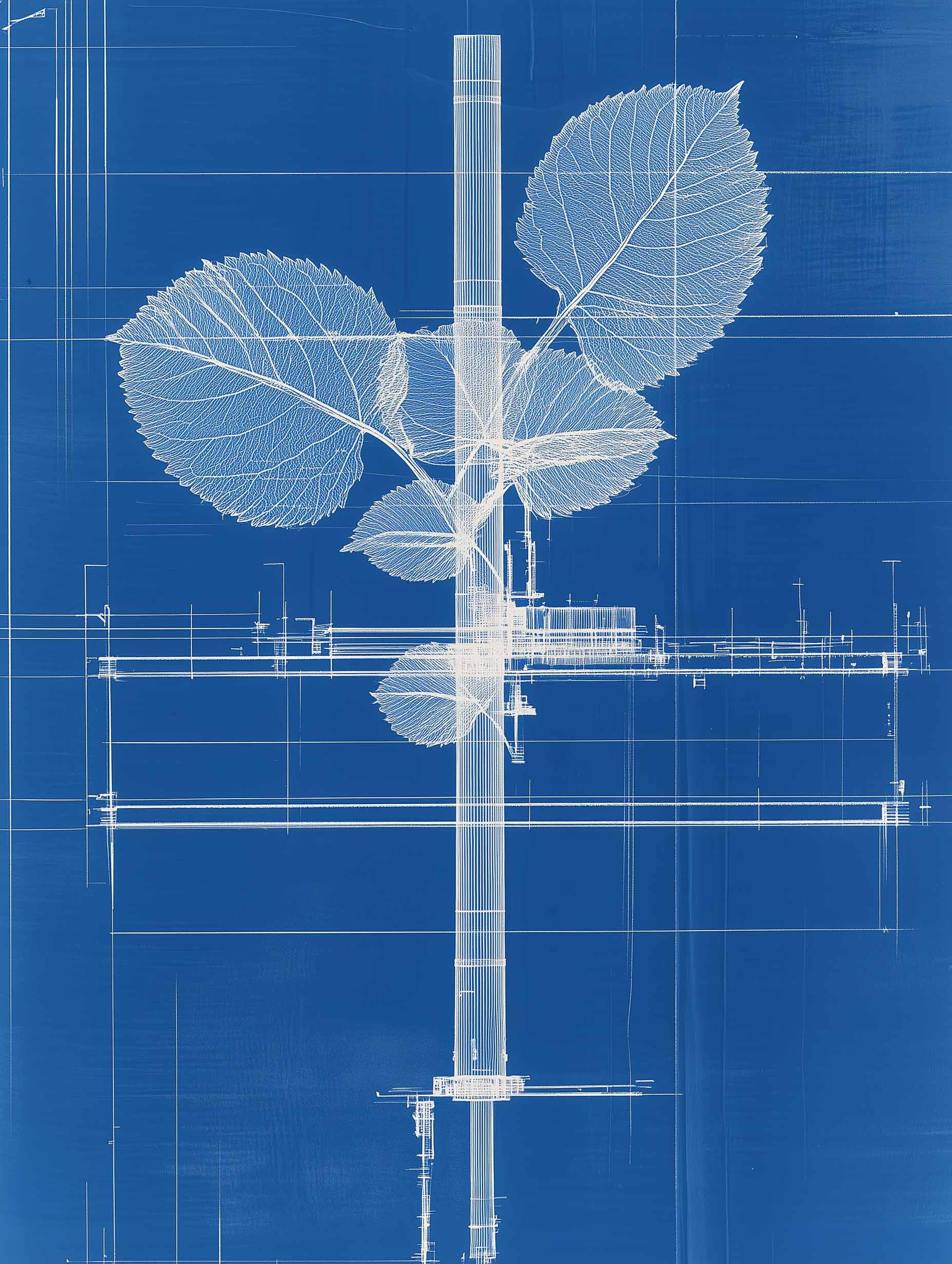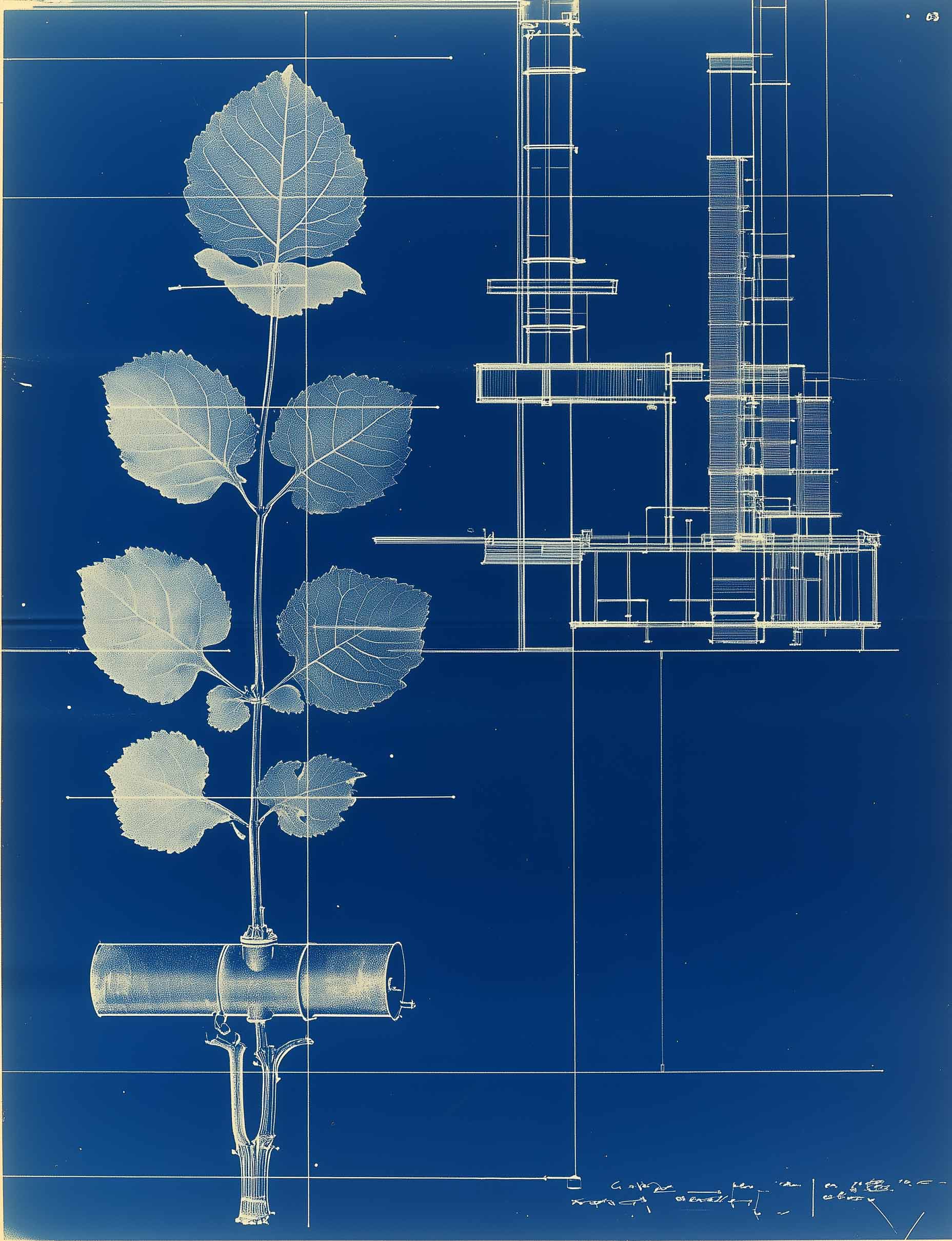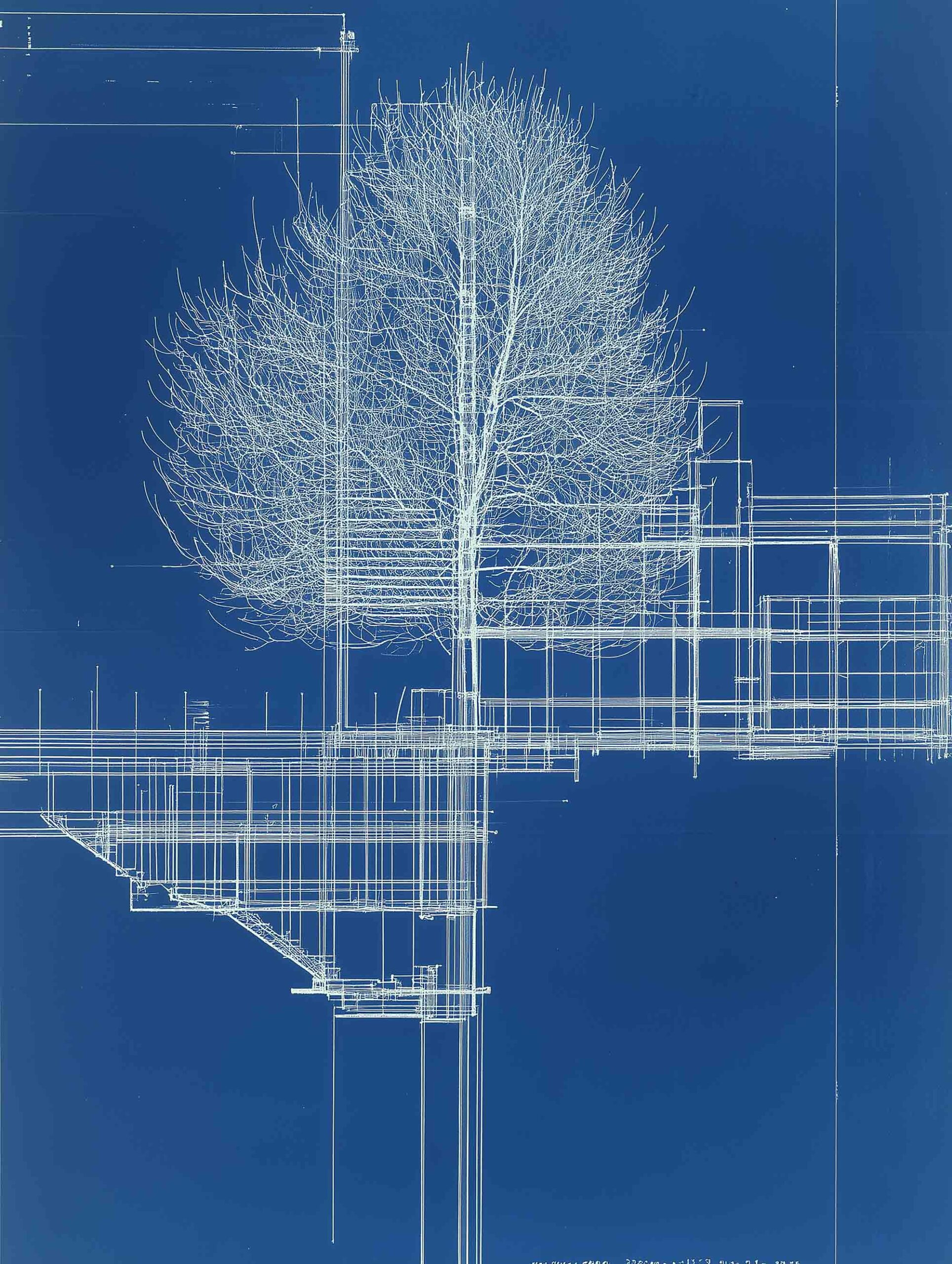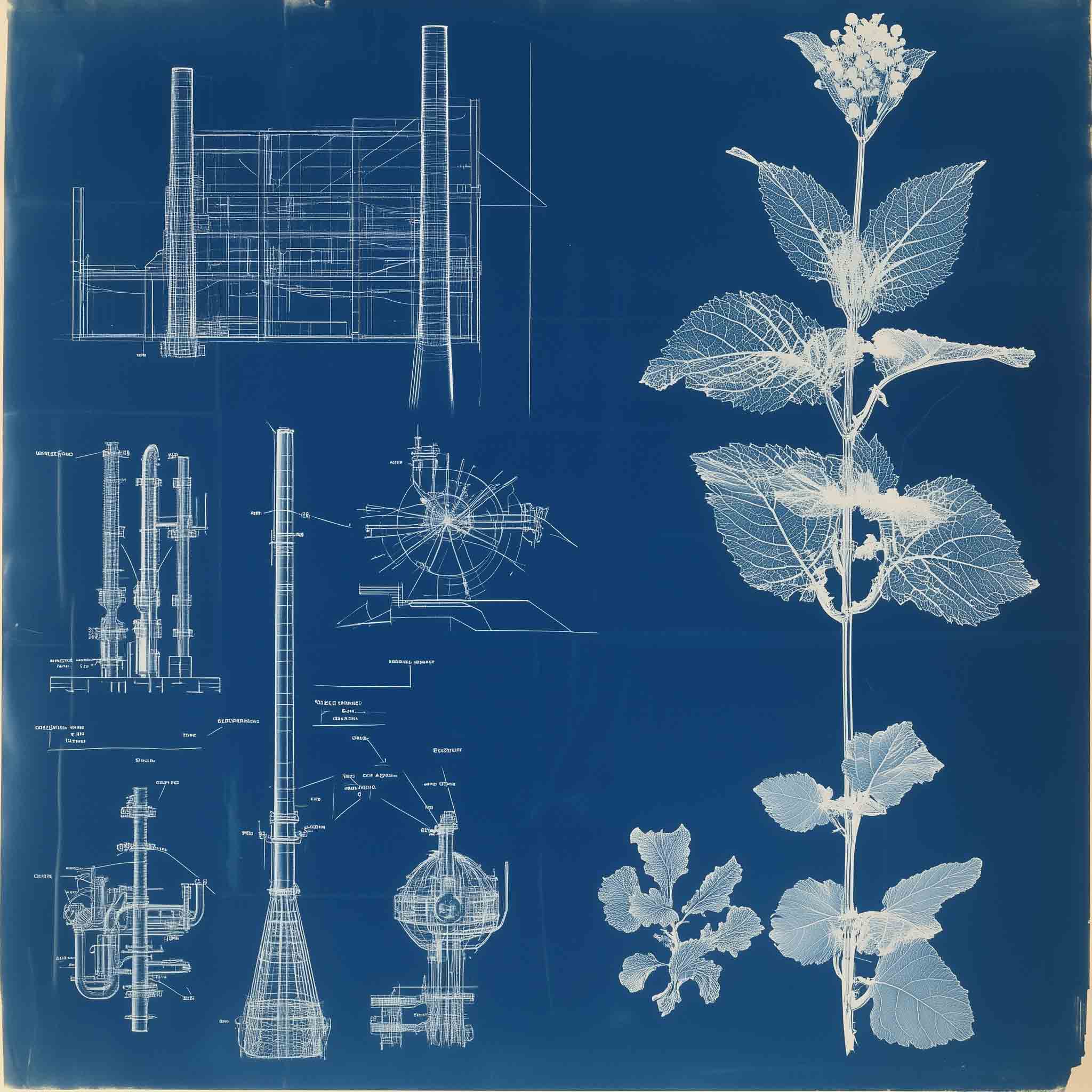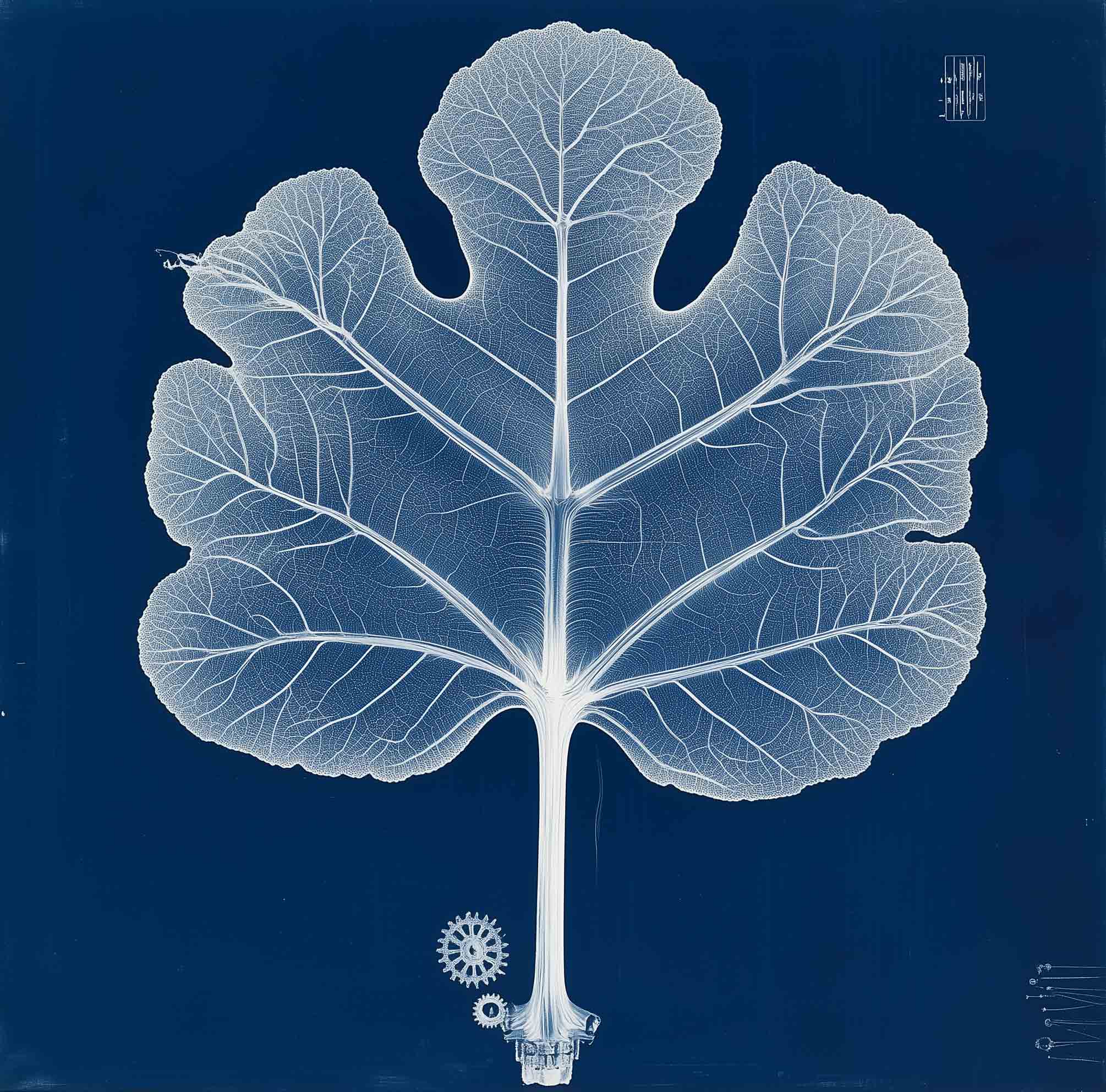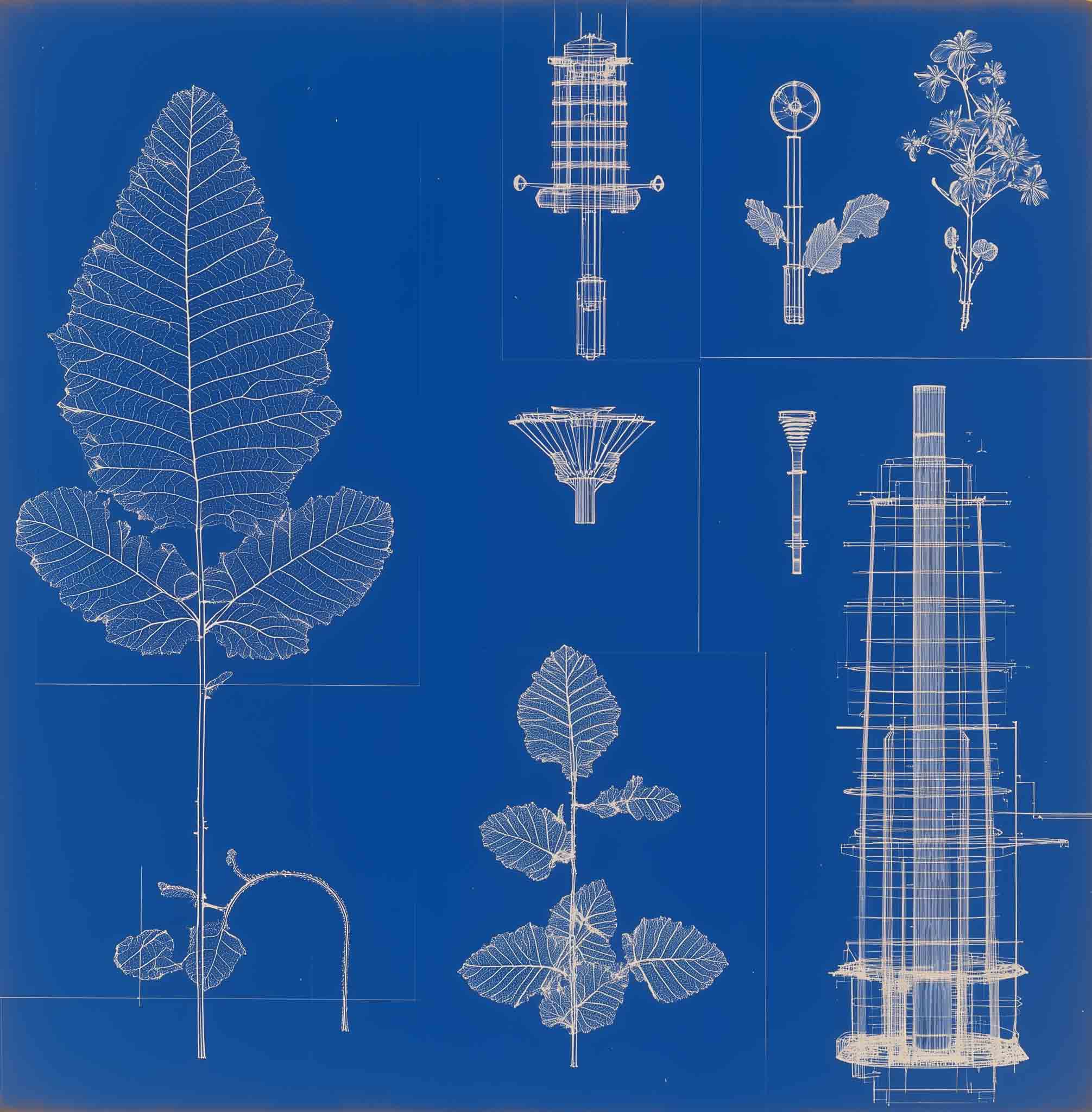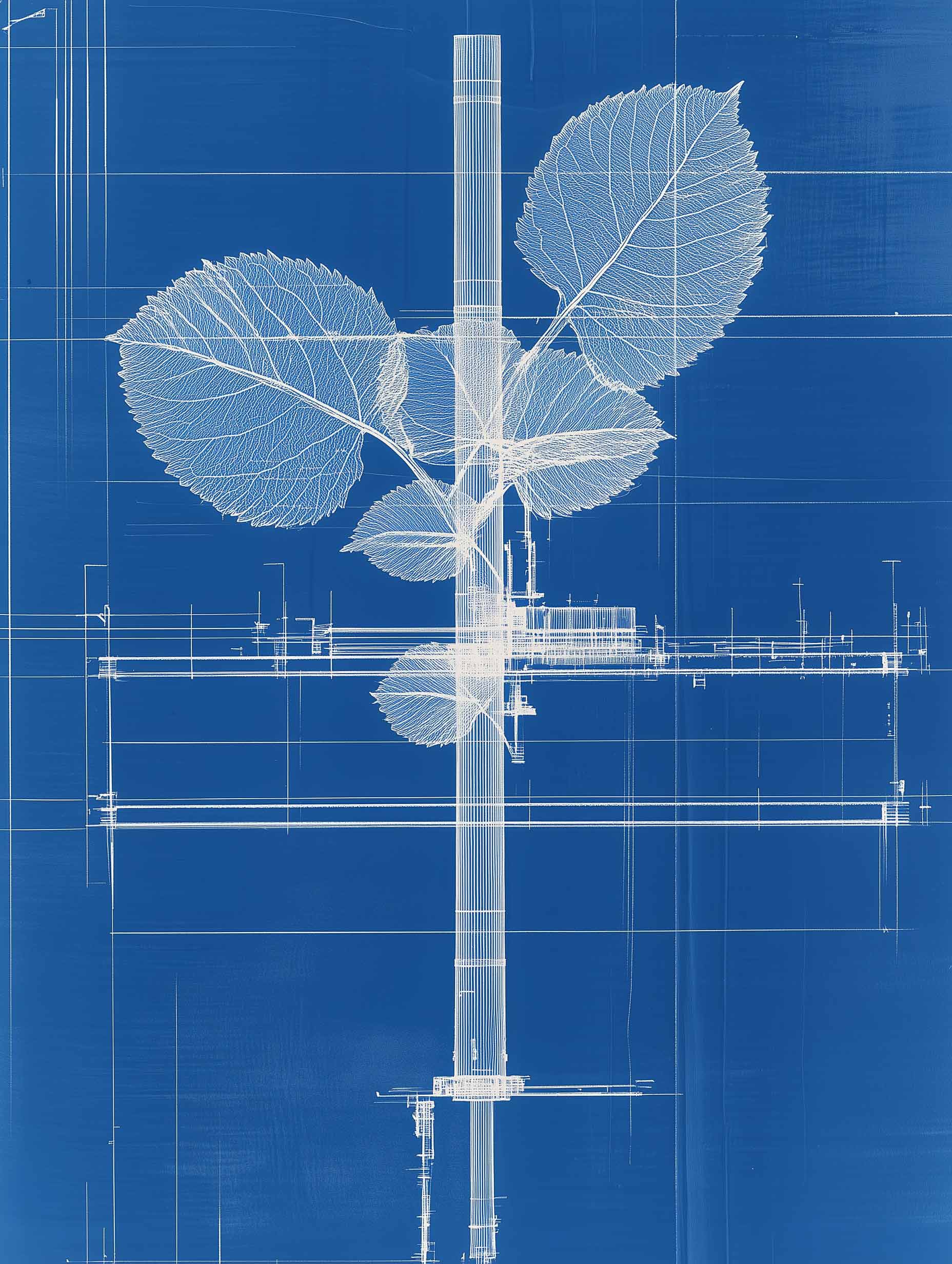Protocolo generativo (i): cartografias fabris abstração territorial e regimes de posse
TITULO: Protocolo generativo (i): cartografias fabris, abstração territorial
e regimes de posse
AUTOR: paula roush
Esta coleção de imagens resultou da fusão de duas coleções de arquivos visuais. A primeira provém do Arquivo Histórico Casa do Infante, Porto, que contém plantas arquitetónicas datadas de antes de 1960. A partir da lista de fábricas e localizações identificadas na deriva através de caminhadas pelas ruínas (p.78) foi possível requisitar o acesso ao ficheiro digital dessas plantas utilizadas na construção e alteração das fábricas. A segunda coleção é composta por fotografias e cianotipias de plantas espontâneas que habitam as ruínas, capturando a relação entre a paisagem industrial abandonada e a regeneração vegetal.
Utilizando um conjunto de imagens de referência para treino, o LLM (Large Language Model) analisou padrões, texturas e estilos das imagens selecionadas, criando sínteses visuais que refletem a fusão entre o traçado arquitetónico industrial e as formas orgânicas das plantas espontâneas. Em vez de buscar um resultado foto-realista, as imagens geradas apresentam um aspeto técnico e esquemático, evocando a precisão dos desenhos arquitetónicos e científicos.
Este efeito visual remete para os sistemas de abstração territorial inscritos nos arquivos, onde os terrenos das fábricas aparecem codificados por meio de grelhas métricas, coordenadas geodésicas, cadastros e tabelas numéricas. Estes aparatos de medição não apenas descrevem o espaço, mas produzem uma forma específica de poder sobre ele, tornando a terra passível de apropriação e circulação dentro de regimes jurídicos e económicos.
No contexto colonial, a posse do território baseou-se na lógica da vacância e da abstração—o espaço foi artificialmente concebido como “vazio” para justificar a sua ocupação, da mesma forma que corpos racializados foram reduzidos à condição de propriedade. Esta abstração não era neutra, mas singular e exclusória, garantindo que a terra e as pessoas permanecessem sob um único regime de propriedade.
Este conceito ressoa com o processo de transformação espacial em Campanhã, onde a lógica da vacância é continuamente reinscrita—seja através do abandono das fábricas, da especulação imobiliária ou da estetização da ruína. As imagens desta coleção procuram explorar como essa noção de abstração e propriedade se manifesta na paisagem industrial e nos rastros materiais que ainda persistem.
Ao conjugar arquivos arquitetónicos e botânicos, a fusão de imagens não apenas reconfigura visualmente a paisagem, mas questiona os mecanismos técnicos, jurídicos e políticos que normalizam a apropriação da terra.
TITLE: Generative Protocol (I): Factory Cartographies, Territorial Abstraction, and Regimes of Ownership
AUTHOR: paula roush
This collection of images emerged from the fusion of two visual archives. The first comes from the Historical Archive Casa do Infante, Porto, which contains architectural plans dating from before 1960. Based on the list of factories and locations identified during field drift walks through the ruins (p.78), it was possible to request access to the digital files of the architectural drawings used in the construction and modification of these factories. The second collection consists of photographs and cyanotypes of spontaneous plants inhabiting the ruins, capturing the relationship between the abandoned industrial landscape and vegetal regeneration.
Using a set of reference images for training, the LLM (Large Language Model) analysed patterns, textures, and styles from the selected materials, generating visual syntheses that reflect the fusion between industrial architectural drafting and the organic forms of spontaneous plants. Rather than aiming for a photo-realistic result, the generated images display a technical and schematic quality, evoking the precision of architectural and scientific drawings.
This visual effect recalls the systems of territorial abstraction inscribed in the archives, where the factory grounds appear codified through metric grids, geodesic coordinates, cadastral records, and numerical tables. These measuring devices do not merely describe space — they produce a specific form of power over it, rendering land susceptible to appropriation and circulation within legal and economic regimes.
In the colonial context, territorial possession was grounded in the logic of vacancy and abstraction — space was artificially conceived as “empty” to justify its occupation, just as racialised bodies were reduced to the condition of property. This abstraction was not neutral, but singular and exclusionary, ensuring that both land and people remained under a single regime of ownership.
This concept resonates with the ongoing spatial transformation in Campanhã, where the logic of vacancy is continually reinscribed — whether through factory abandonment, real-estate speculation, or the aestheticisation of ruin. The images in this collection seek to explore how this notion of abstraction and ownership manifests itself within the industrial landscape and the material traces that persist.
By merging architectural and botanical archives, the image fusion not only reconfigures the landscape visually but also questions the technical, legal, and political mechanisms that normalise the appropriation of land.
TITLE: Protocolos de impressão têxtil
AUTHOR: paula roush
MEDIUM: texteis impressos
No Herbário do Antropoceno, os gestos de impressão têxtil desdobram-se em dois modos distintos de relação com a imagem e a matéria: um baseado na presença vegetal e atmosférica, outro mediado por linguagem e sistemas algorítmicos.
Os protocolos de impressão com matéria vegetal envolvem contacto direto com o território — plantas recolhidas em deriva, tecidos reutilizados, soluções sensíveis à luz. são práticas situadas, ecológicas e tácteis.
Os protocolos de impressão generativa operam por via algorítmica: imagens criadas com base em descrições textuais e inteligência artificial, produzidas por redes neuronais treinadas. Estas imagens, depois de geradas, são impressas em tecido numa fábrica de impressão on demand, e posteriormente manchadas com solução de cianotipia — cruzando síntese maquínica e intervenção manual.
Estes dois regimes de impressão coexistem neste herbário expandido. juntos, desenham uma ecologia da imagem onde o gesto humano é apenas uma das forças que imprime, sonha, contamina e traduz o mundo em transição.
TITLE: Textile printing protocols
AUTHOR: paula roush
MEDIUM: Phytograms (contact and heat printing); Dirty pot (handcrafted eco-dyeing); Solar cyanotypes (light, fabric, and plant); dimensions variable.
In the Herbarium of the Anthropocene, the gestures of textile printing unfold in two distinct modes of relation between image and matter: one grounded in vegetal and atmospheric presence, the other mediated by language and algorithmic systems.
The printing protocols with plant matter involve direct contact with the territory — plants collected while drifting, reused fabrics, and light-sensitive solutions. These are situated, ecological, and tactile practices.
Phytograms (contact and heat printing)
Dirty pot (handcrafted eco-dyeing)
Solar cyanotypes (light, fabric, and plant)
The generative printing protocols operate algorithmically: images created from textual descriptions through artificial intelligence, produced by trained neural networks. Once generated, these images are printed on fabric in an on-demand printing factory and later stained with cyanotype solution — crossing machinic synthesis with manual intervention.
These two regimes of printing coexist within this expanded herbarium. Together, they trace an ecology of the image in which the human gesture is only one of the forces that prints, dreams, contaminates, and translates the world in transition.
contact
paula roush ::: paularoush@gmail.com
msdm studio ::: msdm@msdm.org.uk
